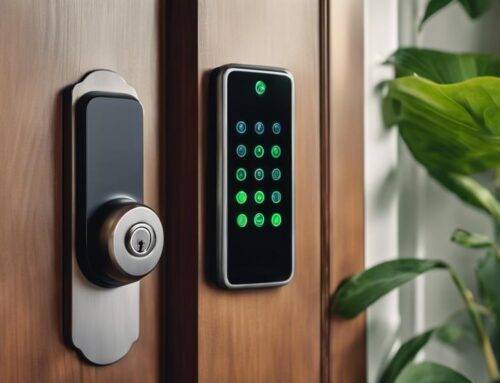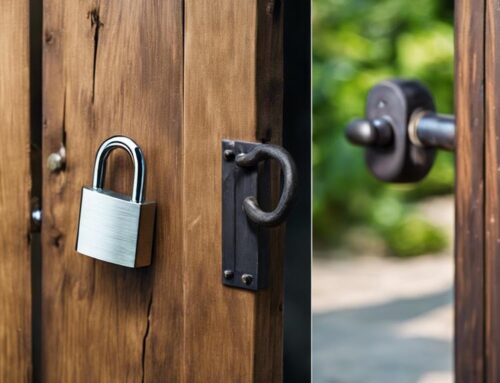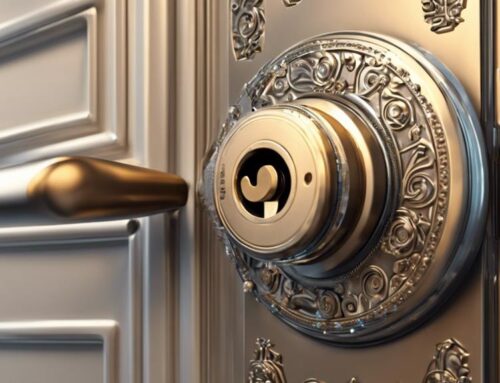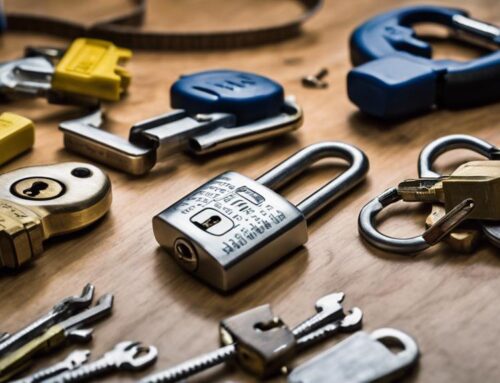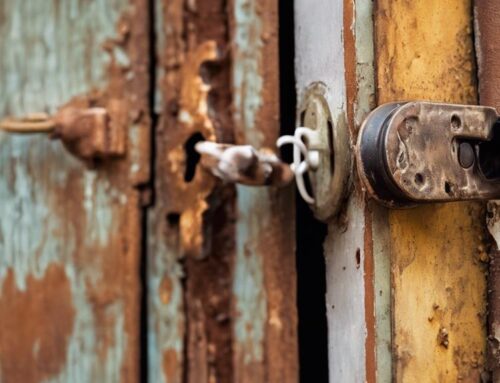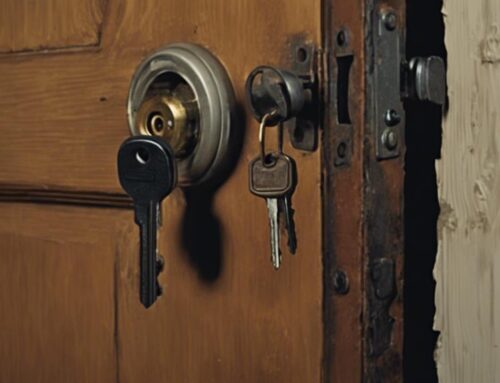Lock bumping is a serious threat to home security, exploiting cylinder locks via specially designed bump keys. To prevent it, start by installing bump-proof locks with anti-bump pins. Consider upgrading to high-security locks from renowned brands like Medeco, which offer complex keyways and reinforced cylinders. Regularly maintain and lubricate your locks, and add extra security layers with door reinforcement bars and smart locks. Additional measures include integrating alarm systems and motion sensor lights to deter potential intruders. Learn how investing in advanced security systems and proactive measures can protect your home like never before.
Introduction

Lock bumping, an insidious technique that exploits common cylinder locks using bump keys, poses a substantial security threat to approximately 90% of American households. The ability of this method to grant unauthorized access without leaving visible signs of forced entry underscores the critical need for effective prevention strategies. By installing bump-proof locks and enhancing overall security measures, homeowners can greatly mitigate the risks associated with this prevalent vulnerability.
Overview of Lock Bumping
With increasing concerns about residential security, understanding the vulnerabilities posed by lock bumping becomes vital for homeowners seeking to protect their properties. Lock bumping is a method that allows intruders to open cheap commercial locks quickly and without leaving signs of forced entry. This technique employs a specially crafted bump key, which is inserted and forcefully struck to make the lock pins jump above the shear line, granting access. Alarmingly, approximately 90% of American households are at risk due to the prevalence of vulnerable locks, especially those on main entry doors and from chain hardware stores. Grasping the mechanics of lock bumping is essential for implementing effective prevention measures and securing your home against this insidious threat.
Importance of Preventing Lock Bumping
Ensuring the security of one’s home through the prevention of lock bumping is crucial in protecting against unauthorized access and potential burglaries. Installing bump-proof or bump-resistant locks is a critical first step in reducing the risk of these invasive techniques. Enhancing visibility around your property and investing in advanced security systems act as important supplementary defenses. Regular maintenance and lubrication of locks contribute to maintaining their integrity, making them less susceptible to manipulation. Upgrading to high-security locks equipped with security pins and side bars further fortifies your home against lock bumping attempts. By taking these proactive measures, homeowners can exert greater control over their security, thereby safeguarding their property and loved ones against potential threats.
Understanding Lock Bumping

Lock bumping, a method of forced entry using specially crafted bump keys, has evolved into a significant security threat for many households. This technique, which exploits the mechanical vulnerabilities of pin-tumbler locks, traces its roots back to the locksmithing practices of the early 20th century. Understanding the mechanics behind lock bumping is essential for comprehending its implications and developing effective preventive measures.
What is Lock Bumping?
Operating as a highly effective method for unauthorized entry, lock bumping utilizes specially designed keys to manipulate the pins within cylinder locks, making it a significant security concern for many households. These bump keys align the lock pins in such a way that permits effortless unauthorized access with minimal signs of forced entry. Alarmingly, around 90% of American households are vulnerable to this technique. Locks commonly found on main entry doors and those purchased from chain hardware stores are particularly at risk. Given its potential to compromise residential security, understanding the mechanics and vulnerabilities associated with lock bumping is essential for homeowners seeking to safeguard their properties. Recognizing this threat allows for informed decisions about better securing one’s home.
History and Evolution of Lock Bumping
Tracing its origins back to the practices of professional locksmiths, the technique of lock bumping has evolved greatly over the decades, transforming from a specialized tool for legitimate access into a prevalent method for illicit entry. Initially used by locksmiths to assist people locked out of their homes, the technique involved the use of bump keys to manipulate lock pins quickly. Over time, the method caught the attention of burglars due to its stealth and simplicity, as bump keys, available for as little as $3 online, provided an easy way to bypass traditional locks. The evolution of lock bumping has markedly impacted residential security, with an estimated 90% of American households now vulnerable to this discreet and effective intrusion method.
How Lock Bumping Works
Building on the historical context of lock bumping‘s evolution from a locksmith’s tool to a burglar’s method of choice, it is essential to understand the mechanics behind this technique to better safeguard against it. Lock bumping involves using a specially crafted key, known as a bump key, to quickly and effectively align the pins within a lock. By applying force to the bump key, all the pins are momentarily driven to the shear line, allowing the lock to be turned. This method leaves no visible signs of forced entry, making it particularly insidious. Bump keys can be easily acquired online for as little as $3, heightening the risk. Understanding this technique is vital for implementing effective countermeasures to protect your property.
Vulnerable Locks

Identifying vulnerable locks is essential in preventing lock bumping. Types of locks particularly susceptible include those with loose keyways, visible wear, and rust, which are telltale signs of compromised security. Regular maintenance, upgrades to bump-resistant locks, and considering electronic or smart options can greatly enhance your protection against unauthorized access.
Types of Locks Susceptible to Lock Bumping
Many common cylinder locks available at chain hardware stores are particularly susceptible to lock bumping, making them frequent targets for unauthorized entry. Standard pin tumbler locks, which are widely used in main entry doors, are especially vulnerable. This alarming reality places about 90% of American households at risk. The design of these locks allows a special bump key to align the pins and open the door with minimal effort. Older models without enhanced security features, such as anti-bump pins or side bars, are even more at risk. To mitigate this vulnerability, upgrading to bump-proof locks, which incorporate advanced security measures like security pins and additional internal mechanisms, is essential. Taking these steps drastically reduces the likelihood of unauthorized access.
Common Signs Your Lock May Be Vulnerable
A variety of indicators, such as loose keyways, difficulty turning keys, rust, wear, and unusual sounds, can signal that your lock is vulnerable to lock bumping. Visible damage should never be ignored, as it often indicates that your lock can be easily compromised. To maintain control over your security, consider upgrading to bump-proof locks, which feature advanced mechanisms like security pins and side bars. Additionally, electronic or smart locks offer substantial protection due to their sophisticated security features. For enhanced safety, installing deadbolts can add an extra layer of defense against intruders attempting to bypass traditional locking methods. By recognizing these signs and taking proactive measures, you can greatly reduce the risk of lock bumping.
Preventive Measures
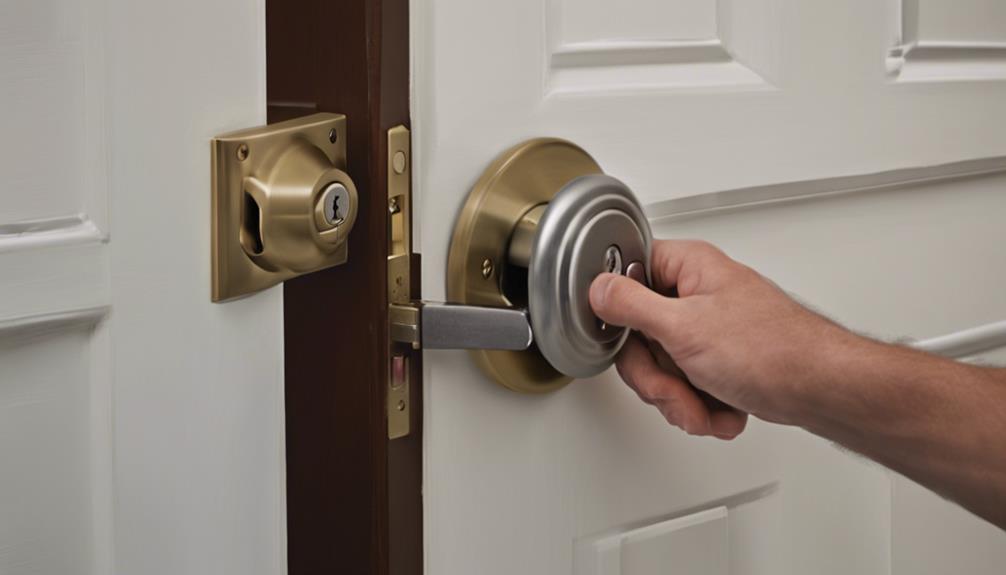
To effectively prevent lock bumping, it is essential to install high-security locks equipped with advanced features such as anti-bump pins. High-security locks, designed with cutting-edge anti-bump mechanisms, offer a strong defense against unauthorized entry. By exploring various recommended high-security locks and understanding their specific anti-bump features, homeowners can greatly enhance their property’s security.
High-Security Locks
In the domain of property security, high-security locks stand as a formidable deterrent against lock bumping due to their advanced design and robust features. These locks are engineered to be bump-proof and pick-proof, offering unparalleled protection. Brands like MultiLock exemplify this with unique features such as ball bearings, which enhance security. High-security locks often come with high-security ratings and require special keys and keyways, ensuring thorough access control. Though they represent a significant investment, their effectiveness in safeguarding property justifies the cost. To maximize security, integrate high-security locks with other preventive measures, creating a well-rounded system that effectively deters burglars. This layered approach empowers property owners with greater control over their security.
Features of High-Security Locks
High-security locks incorporate advanced mechanisms such as anti-drill plates, reinforced cylinders, and complex keyways, making them highly effective in preventing unauthorized access. These locks are meticulously designed to be bump-proof and pick-proof, ensuring the highest level of security for your home or business. Special keys and keyways add another layer of difficulty for potential intruders, making manipulation nearly impossible. Brands like MultiLock enhance protection with unique features, including ball bearings that guard against drilling or picking attempts. While the initial investment in high-security locks can be higher, the unparalleled security and peace of mind they offer make them indispensable for safeguarding valuable assets and ensuring the safety of your property against various intrusion methods.
Recommended High-Security Locks
Choosing the appropriate high-security locks is essential for effectively preventing lock bumping and ensuring the utmost protection for your property. High-security locks, such as those from the MultiLock brand, are designed to be both bump-proof and pick-proof, offering unparalleled security. These advanced locks utilize special keys and keyways, making unauthorized access virtually impossible. Features like ball bearings further enhance their robustness, providing an additional layer of defense. While these locks may come at a higher cost compared to standard options, the investment is justified by the superior protection they offer. Opting for high-security locks with advanced features is a prudent measure, reducing the risk of lock bumping and safeguarding your peace of mind.
Anti-Bump Lock Mechanisms
Effective anti-bump lock mechanisms, such as those incorporating spool pins, offer a robust defense against unauthorized entry by creating a binding effect during attempted attacks. These high-security locks utilize spool pins that spin slightly when manipulated, causing them to fall back below the shear line and thwarting bumping attempts. This method is both effective and cost-efficient. Enhancing security further, combining spool pins with restricted keyways can greatly deter both bumping and picking techniques. Remarkably, Medeco X4 cylinders employ spool pins to provide pick-proof and durable protection, making it nearly impossible to bump the lock. For those seeking control and peace of mind, investing in locks with these advanced features is a prudent and proactive measure.
Overview of Anti-Bump Pins
Anti-bump pins, integral components of modern high-security locks, are meticulously engineered to impede lock bumping techniques by necessitating precise alignment for successful entry. These specialized security pins create additional resistance within the lock cylinder, making it considerably harder for bump keys to manipulate the lock’s internal pins. By demanding exact alignment of each pin, anti-bump pins thwart unauthorized access attempts, thereby enhancing the overall security of the lock. Commonly installed in high-security locks, these pins serve as a formidable deterrent against bumping attacks. Implementing locks with anti-bump pins is a proactive measure that effectively safeguards properties against this prevalent threat, ensuring peace of mind for those who prioritize control over their security.
Effectiveness of Anti-Bump Mechanisms
How do anti-bump mechanisms, including spool pins and restricted keyways, fortify against lock bumping attempts and guarantee heightened security for modern locks? Spool pins, by creating a binding effect, are an efficient and cost-effective measure to thwart bumping and picking. This mechanism complicates the alignment of pins, making unauthorized entry substantially more challenging. When combined with restricted keyways, such as Medeco X4 cylinders, the security is further amplified. These keyways feature unique patterns that make bumping virtually impossible. Implementing both spool pins and restricted keyways ensures a robust defense, offering homeowners and businesses heightened control over their security. This dual-layer strategy is essential for anyone looking to safeguard their property against the prevalent threat of lock bumping.
Smart Locks as an Alternative
While traditional locks fortified with anti-bump mechanisms provide robust security, smart locks present an innovative alternative that leverages advanced technology to virtually eliminate the threat of lock bumping. Utilizing biometrics or digital keys, smart locks render traditional bumping techniques obsolete. Keyless entry options further mitigate bump key attacks, ensuring enhanced security. These sophisticated devices can be remotely managed via smartphones or voice assistants, granting users unparalleled control and convenience. Additionally, features such as activity logs and real-time alerts allow for meticulous monitoring of access, enhancing overall property security. By upgrading to smart locks, homeowners can achieve a higher level of security and peace of mind, effectively countering the pervasive threat of lock bumping.
Benefits of Smart Locks
Smart locks provide a cutting-edge solution to lock bumping by offering keyless entry options and advanced security features that greatly reduce the risk of unauthorized access. These state-of-the-art devices eliminate the vulnerabilities associated with traditional keys, leveraging remote access and activity logs for enhanced security monitoring. Integrating smart locks into existing home automation systems not only boosts convenience but also fortifies security frameworks. Features such as tamper alerts and auto-locking mechanisms act as formidable deterrents against potential intrusions. Additionally, mobile app control allows homeowners to secure and open doors remotely, adding an extra layer of defense against lock bumping. Embracing smart locks empowers you to exercise greater control over your home’s security, ensuring peace of mind.
Best Smart Locks to Consider
To maximize the benefits of smart locks in preventing lock bumping, consider these top-rated models renowned for their advanced security features and user-friendly integration. The August Smart Lock Pro offers keyless entry and remote access control, ensuring you can manage your locks from anywhere. The Schlage Encode Smart WiFi Deadbolt integrates seamlessly with smart home systems and provides voice control via Alexa or Google Assistant. For versatility, the Ultraloq U-Bolt Pro combines fingerprint, keypad, and key access options. These smart locks also offer real-time activity monitoring and customizable access codes, adding an extra layer of security. By integrating these smart locks, you enhance convenience and maintain control over your home’s security with cutting-edge technology.
DIY Solutions and Temporary Fixes
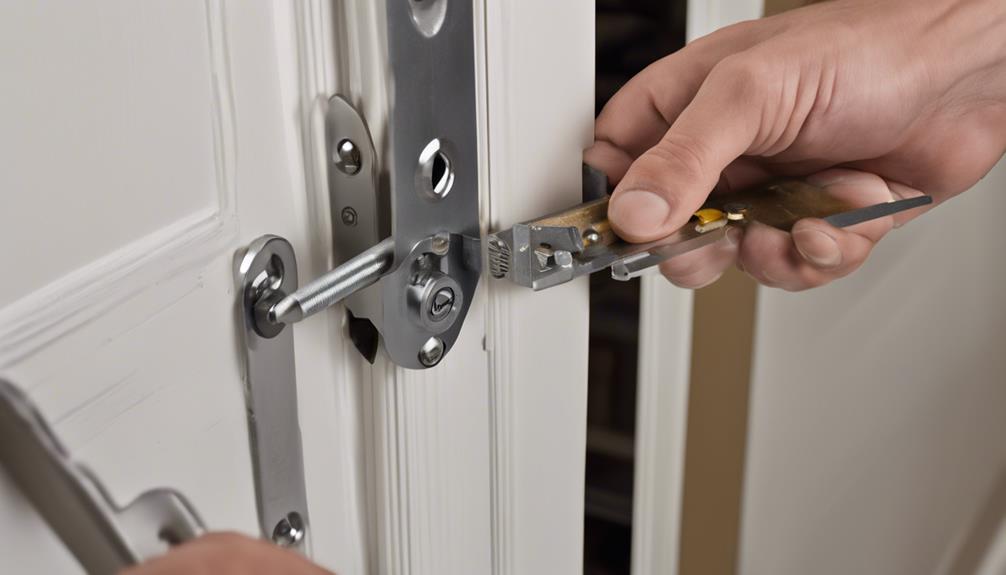
For homeowners seeking immediate protection against lock bumping, simple DIY methods and temporary solutions offer practical and cost-effective options. Techniques such as using a strap to secure deadbolts or installing half deadbolts can greatly enhance security. Additionally, products like the Smart Key provide quick, user-friendly alternatives to traditional locks, making it easier to safeguard your home while considering long-term upgrades.
Simple DIY Methods to Enhance Security
Securing your home against lock bumping can start with simple and cost-effective DIY methods that offer immediate protection. One effective solution is using a strap to secure deadbolts, a method that can be implemented within seconds and costs less than $12. This quick fix prevents the lock from turning, thereby thwarting bumping attempts. For those looking to invest a bit more, installing half deadbolts can greatly enhance security. Priced at approximately $75 per door, professional installation guarantees top performance. Combining these measures, such as the strap with bump-resistant high-security locks and Smart Key technology, creates a robust, multi-layered defense system. These strategies provide homeowners with a sense of control and peace of mind.
Temporary Solutions Until You Upgrade
When immediate security enhancements are needed, temporary DIY solutions can provide an effective stopgap until more permanent upgrades are installed. One quick and cost-effective measure is using a simple strap to secure the deadbolt, preventing it from turning. Priced at less than $12, this solution is both affordable and easy to install. Additionally, quick set products like Smart Key locks utilize wafers instead of traditional pins, offering enhanced resistance to lock bumping. For doors, consider installing half deadbolts, which feature an interior thumb turn but no visible exterior lock. This design complicates unauthorized access, providing an additional layer of security. These temporary fixes can greatly improve your home’s protection while you plan for more robust security upgrades.
Professional Locksmith Solutions
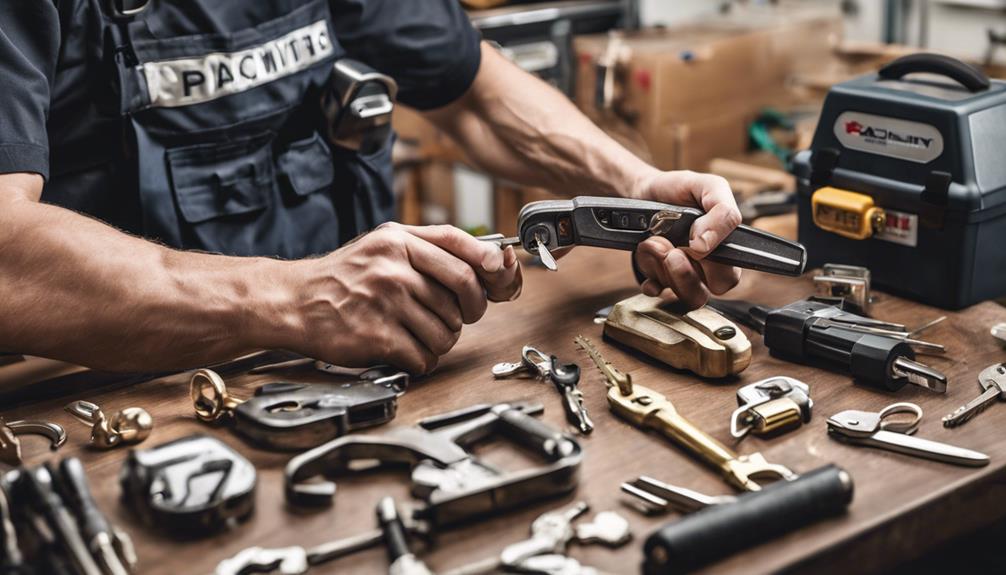
Professional locksmiths offer an array of solutions designed to fortify your security against lock bumping. These services include re-keying existing locks, installing advanced bump-proof mechanisms, and conducting regular maintenance and inspections to guarantee peak protection. By leveraging their expertise, you can achieve a tailored, robust defense against unauthorized access, enhancing the safety of your property.
Re-keying Your Existing Locks
Re-keying your existing locks is a practical and effective method to enhance security by altering the internal mechanisms so that old keys no longer function. This process involves changing the pins and springs inside the lock to create a new key pattern, ensuring that any previous keys are rendered useless. Professional locksmiths can execute this task swiftly and efficiently, making it an economical option for bolstering security. Re-keying is ideal for scenarios such as lost or stolen keys, moving into a new residence, or simply upgrading your security measures. This proactive step is a recommended practice to maintain control over access to your property, providing peace of mind without the need for complete lock replacement.
Installing Bump-Proof Locks
Upgrading your security measures can further be achieved by installing bump-proof locks, a sophisticated solution designed to combat the vulnerabilities of traditional locking mechanisms. These advanced locks incorporate security features specifically engineered to resist the manipulation techniques employed in lock bumping. Professional locksmiths bring invaluable expertise to this process, evaluating your current locks and recommending bump-proof alternatives tailored to your unique security needs. By investing in these high-security locks, you are taking a proactive approach to prevent unauthorized access and guarantee the safety of your property. Let a skilled locksmith guide you through selecting and installing the most effective bump-proof solutions, offering you enhanced peace of mind and robust protection against potential intrusions.
Regular Maintenance and Inspections
Engaging in regular maintenance and inspections by a certified locksmith is essential for identifying and addressing potential vulnerabilities in your locking systems. Professional locksmiths possess the expertise to detect weaknesses that could lead to unauthorized access, such as susceptibilities to lock bumping. They can recommend and install bump-proof locks, providing a tailored approach to enhance your home security. Regularly scheduled maintenance can also involve rekeying locks and upgrading to bump-resistant options, ensuring your property remains secure. By entrusting these tasks to a professional, you gain peace of mind knowing that your locks are consistently evaluated and fortified against emerging threats. This proactive approach allows you to maintain control over your security environment, preventing potential breaches before they occur.
Additional Security Measures
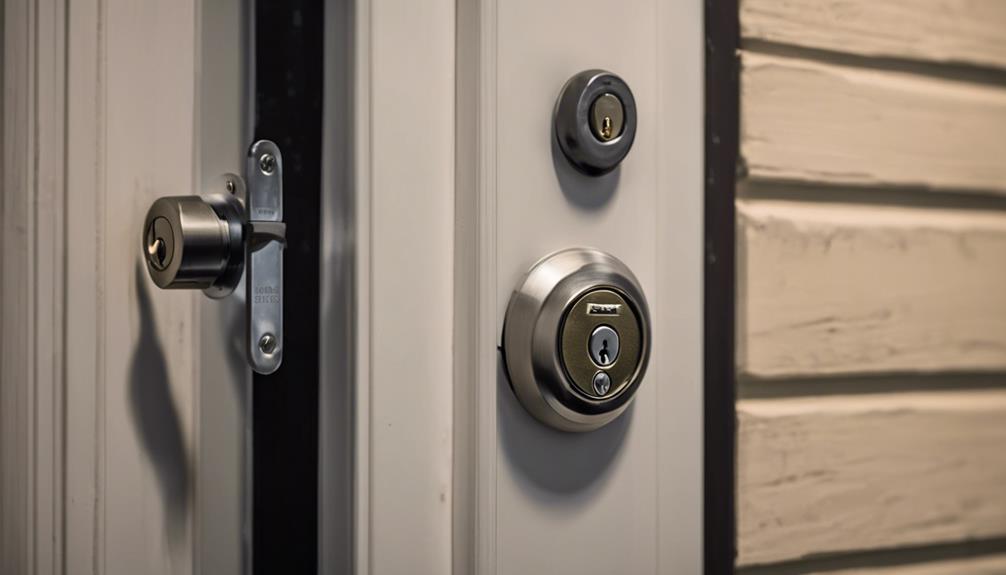
To further fortify your home against lock bumping, it is essential to think about complementary security devices such as door reinforcements, security cameras, and alarm systems. These measures, when combined with best practices for home security, create a multi-layered defense that greatly deters unauthorized access. By integrating a variety of tailored security products, homeowners can achieve a robust and complete safeguard against potential threats.
Complementary Security Devices
Complementary security devices, such as door reinforcement bars and high-quality strike plates, greatly enhance a home’s defenses against forced entry. Security cameras and smart doorbells not only provide real-time visual monitoring but also serve as effective deterrents to potential intruders. Window security film and sensors are essential for alerting homeowners to unauthorized entry attempts, adding another layer of protection. Additionally, motion sensor lights can illuminate dark areas, startling would-be intruders and increasing the security of your property. For those seeking the utmost in home protection, integrating a home security system with 24/7 monitoring offers thorough coverage against break-ins, providing peace of mind and a strong defense against any unauthorized access attempts.
Door Reinforcements
Enhancing the security of your home involves not only supplementary devices but also the strategic reinforcement of door structures to withstand forced entry attempts. Installing heavy-duty deadbolts and reinforced door frames can greatly enhance your defense against break-ins. Door reinforcements like door jammers, strike plates, and door viewers are cost-effective solutions that can fortify entry points and deter burglars. Additionally, security bars and door braces provide robust protection by blocking forced entry through doors. Utilizing longer screws to secure door hinges and strike plates can further bolster the structural integrity of your doors. These measures not only improve the physical security of your home but also empower you with greater control over your safety.
Security Cameras
When considering additional security measures for your home, security cameras stand out as a highly effective solution for deterring unauthorized entry and monitoring property surroundings with precision. Installing security cameras enhances home security by providing continuous visual surveillance, capturing evidence of suspicious activity, and aiding in the identification of intruders. Pairing these cameras with motion sensor lights creates a thorough security system that not only records but also actively deters potential threats. Integrating security cameras into your overall home security strategy adds an invaluable layer of protection against burglaries, offering peace of mind and assertive control over your property. By leveraging advanced technology, homeowners can greatly reduce the risk of unauthorized access and maintain a vigilant watch over their surroundings.
Alarm Systems
Alarm systems, as an essential component of a thorough home security strategy, provide an indispensable layer of protection by deterring potential burglars and alerting homeowners to unauthorized access. These systems often include sensors on doors and windows, motion detectors, and audible alarms that offer immediate alerts. By integrating with smart home technology, alarm systems allow for remote monitoring and control, giving homeowners an additional sense of security. Moreover, professional monitoring services can be enlisted to dispatch authorities in case of a security breach, ensuring a prompt response. Regular maintenance and testing are critical to guarantee that alarm systems function effectively in emergencies, providing peace of mind and a robust defense against intruders.
Best Practices for Home Security
Implementing a combination of advanced security products and strategic measures is paramount to fortifying your home against potential intruders. Start by upgrading to bump-resistant locks and deadbolts, which offer a robust defense against lock bumping. High-security locks featuring ball bearings and special keyways provide an additional layer of protection. Enhance exterior security by installing motion sensor lights and security cameras to deter unwanted activity. For thorough home protection, consider integrating various security products such as Smart Key systems, straps, and half deadbolts. Finally, opt for high-security locks with the highest lock rating to guarantee maximum resistance against sophisticated lock bumping techniques. These measures collectively create a strong barrier against intrusions, giving you peace of mind.
Routine Security Checks
Regularly conducting thorough security checks is essential to pinpoint vulnerabilities in your home’s defenses and guarantee all security measures remain effective. Begin by inspecting door locks, windows, and other entry points for any signs of wear, damage, or tampering. This proactive approach helps in identifying and addressing potential weak points before they can be exploited. Implementing additional security measures, such as installing motion sensor lights and security cameras, can greatly deter potential intruders. Moreover, joining neighborhood watch programs can enhance overall security and increase vigilance within your community. Adhering to these practices not only strengthens your home security but also substantially reduces the risk of unauthorized access, ensuring peace of mind for you and your loved ones.
Awareness and Education
Educating yourself about lock bumping and the vulnerabilities of traditional locks is an essential step in fortifying your home against potential break-ins. Understanding these weaknesses allows you to make informed decisions on enhancing your security. Awareness of advanced security measures, such as installing half deadbolts and high-security locks, can greatly deter burglars. Familiarizing yourself with innovative products like the strap and Smart Key provides simple yet effective solutions to prevent lock bumping. By combining various security measures based on thorough education and awareness, you can create a formidable defense against this common threat. Staying informed and proactive is key to maintaining control over your home’s security and ensuring peace of mind.
Case Studies and Real-Life Examples

Real-life examples of lock bumping incidents underscore the critical need for enhanced security measures. Various case studies reveal how homeowners and businesses have successfully upgraded to bump-proof locks, effectively thwarting unauthorized access attempts. Testimonials from satisfied customers further highlight the peace of mind and heightened security achieved through proactive prevention strategies.
Instances of Lock Bumping and How They Were Prevented
In an era where lock bumping has become a prevalent security threat, various case studies reveal effective preventive measures that homeowners, businesses, and communities have successfully implemented. One homeowner installed high-security locks with special keyways, thwarting potential bumping attempts. A business upgraded to electronic access control systems, integrating advanced security measures to combat this issue. Residential communities saw a reduction in incidents by enhancing visibility and initiating neighborhood watch programs. An apartment complex fortified entry points with bump-resistant locks and deadbolts. Additionally, a retail store successfully prevented lock bumping by upgrading to smart locks featuring unique key patterns and remote access capabilities. These examples underscore the importance of proactive and innovative security measures to deter unauthorized access.
Testimonials from Satisfied Customers
Drawing from firsthand experiences, satisfied customers recount how implementing advanced security measures effectively safeguarded their properties against lock bumping. Real-life case studies vividly demonstrate the success of proactive measures, such as high-security locks and bump-resistant mechanisms. One homeowner shared their relief after upgrading to anti-bump locks, which thwarted an attempted break-in. Another business owner emphasized the peace of mind gained from professional locksmith consultations, leading to a fortified security system. These testimonials underscore the importance of adopting reliable preventative strategies. Hearing directly from those who have successfully deterred lock bumping offers invaluable insights, empowering you to take control of your property’s security and mitigate potential risks effectively.
Conclusion
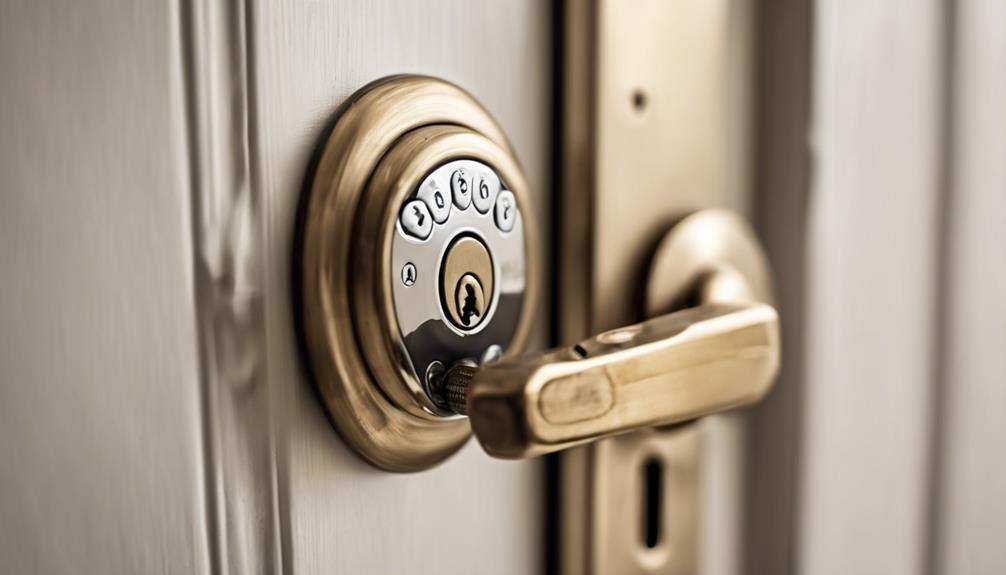
To conclude, a thorough understanding of the threat of lock bumping and implementing a range of security measures, such as upgrading to bump-proof locks and adding security pins, are essential steps in fortifying your property. We recommend consulting professional locksmith services for expert assessment and installation of advanced security solutions. For thorough protection, consider additional measures such as deadbolts and electronic locks, and contact Low Rate Locksmith for personalized assistance.
Recap of Key Points
Summarizing the essential points, preventing lock bumping requires upgrading to high-security locks, recognizing signs of vulnerability, seeking professional locksmith services, and enhancing overall home security with additional measures. High-security locks, such as bump-proof or bump-resistant models, provide a robust first line of defense. Identifying signs of wear, such as loose keyways, difficulty turning keys, rust, and unusual sounds, is important for addressing potential vulnerabilities. Engaging professional locksmith services guarantees that your locks are assessed and upgraded effectively. Supplementing these efforts with additional security measures like motion sensor lights and security cameras further fortifies your home against intruders. By taking these thorough steps, homeowners can significantly reduce the risk of lock bumping and enhance their overall security.
Final Recommendations
To effectively safeguard your home against lock bumping, it is crucial to implement a thorough security strategy that includes upgrading to high-security locks, utilizing additional protective measures, and ensuring regular maintenance. Consider installing bump-proof or bump-resistant locks as the first line of defense. Complement these with temporary lock guards or additional deadbolts for added security. Regularly maintain and lubricate your locks to keep them in excellent condition, deterring potential bumping attempts. Additionally, investing in electronic or smart locks can provide a strong deterrent against such intrusions. Finally, seeking professional locksmith services for a detailed lock assessment and timely upgrades will greatly enhance your home’s security, ensuring peace of mind and control over your safety.
Contact Information for Low Rate Locksmith
For expert guidance on preventing lock bumping and securing your home, reach out to Low Rate Locksmith at 1-800-474-2450. Their team offers professional assistance in upgrading to bump-proof locks, ensuring your home remains secure against modern lock bumping techniques. Visit their website at lowratelocksmith.com for valuable resources, including detailed guides and service options tailored to your specific needs. With customized solutions and a commitment to high-quality security, Low Rate Locksmith is your go-to source for safeguarding your property. Trust their expertise to provide peace of mind and control over your home’s security. Contact Low Rate Locksmith today to fortify your defenses against lock bumping threats.
Frequently Asked Questions
How Can I Identify if My Lock Has Been Bumped?
To identify if your lock has been bumped, look for unusual smooth turning of the key without resistance, or if the lock suddenly feels different. Inspect the keyway for scratches or marks indicating tampering. Also, check for unusual wear patterns on the key or keyway. Absence of forced entry signs and a lock that stops working unexpectedly are strong indicators of potential bumping.
Are Smart Locks Immune to Lock Bumping?
Are smart locks truly immune to lock bumping? While smart locks provide advanced security features, they are not completely impervious to bumping techniques. However, they often incorporate enhanced encryption and authentication methods that greatly bolster their defense. Regular firmware updates can address vulnerabilities, and combining smart locks with additional physical security measures further fortifies protection. Therefore, while not entirely immune, smart locks offer a higher level of security against bumping.
What Tools Are Commonly Used for Lock Bumping?
Essential tools for lock bumping include bump keys, which align lock pins to open cylinders effortlessly, and lock pick guns, facilitating quick, keyless entry. Additionally, bump hammers are utilized by some professionals to deliver the necessary force for bumping locks open. Understanding these tools is vital for implementing robust security measures, ensuring that your locks remain secure against unauthorized access.
Does Lock Bumping Cause Visible Damage to the Lock?
Ironically, the subtlety of lock bumping is its most alarming trait—it leaves no visible damage to the lock. This covert technique aligns the pins in the cylinder seamlessly, enabling intruders to gain access without a trace. For those who value control and security, understanding that a lock can be compromised without physical evidence underscores the importance of proactive measures to safeguard one’s property against such undetectable intrusions.
Can Insurance Cover Damages From Lock Bumping?
Insurance coverage for damages resulting from lock bumping can vary greatly by policy and provider. Some policies may include such damages under the forced entry category, but it is important to review your specific policy details. Documenting evidence of forced entry through lock bumping is vital for a successful claim. Consulting with your insurance agent will clarify your coverage and help you explore options for additional protection.

